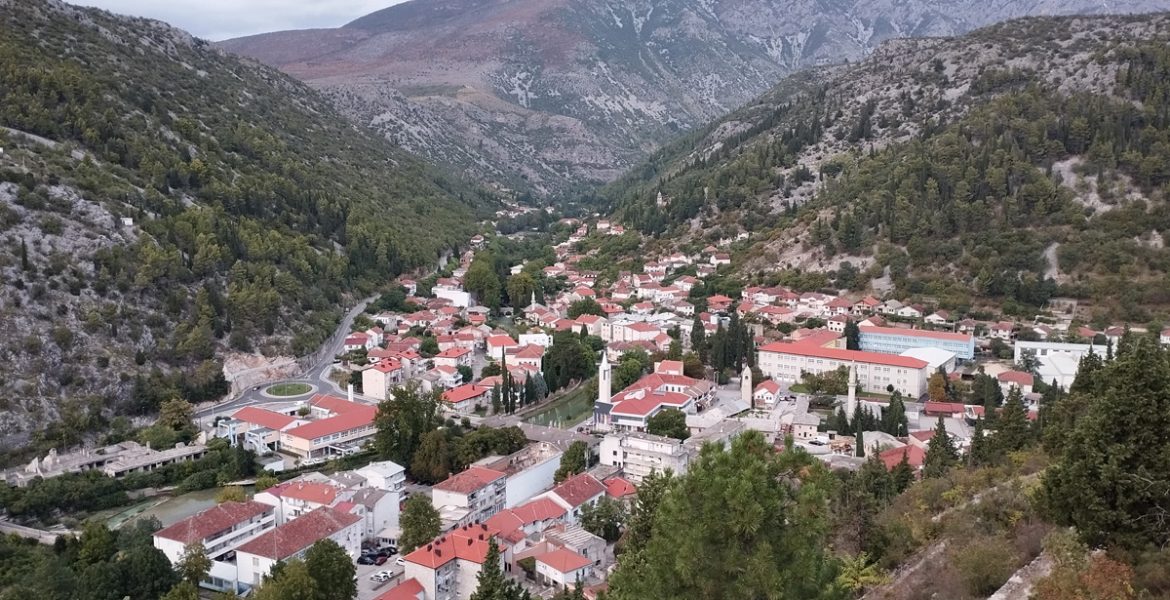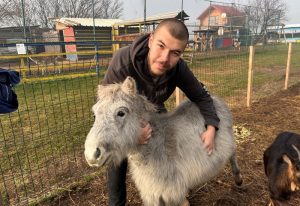Although Stolac still carries difficult memories of the war years, positive developments are also visible. Local connoisseurs record which actors of public, cultural, and then political life bought properties here relatively recently. “The changes were brought about by the opening of the road to Neum. The stool is no longer the appendix it used to be,” says Demir Mahmutćehajić
I’m a pensioner, what do you have to ask me about living in Stolac? How will I live with a five hundred mark pension? I sit on a bench in that park all day, and when the sun gets cold, I come over here – says Ragib, a pensioner from Stolac, while sitting with his partner on a wall under which the Bregava lazily flows. They are not in the mood to take pictures, but they are in the mood for conversation.
– I worked for you as a carpenter for 50 years, there is no place where I was not there – from Mostar and Sarajevo to Stolac. This is where I worked for the longest time – remembers Ragib, pointing vaguely towards the buildings in the center, as if he wanted to convey where he had built his whole life by stretching the beams.
Stolac, located in the southeastern part of Bosnia and Herzegovina, is a real gem of Herzegovina. The city is nestled on the banks of the Bregava River, which gives this place a special charm with its crystal clear waters. Surrounded by the Hrgud and Vidovo polje mountains, Stolac enjoys a Mediterranean climate with mild winters and warm summers. This geographical position not only provides natural beauty, but also enables rich agricultural production, especially olives and vines.
Summer is already getting a bit busy for us residents. If you’ve seen it – it’s like Makarska, I can’t drink coffee in the city at night. A lot of people say that it is better to settle in Stolac, and during the day go to the sea in Neum, and then come back to Stolac again – the citizens point out.
In the very center of the city, the traces of the war are still visible, empty and ruined buildings are still gaping in the best locations. The sun has already made its way to the west, there towards Dolumi and Prenje, from the nearby minaret of the Sultan-Selim mosque, the call to prayer sounds, which is accompanied by the bell from the church of St. Ilije, while we climb the steep road towards the old town, which towers over the town like a stone giant.
The old town of Vidoški, located on a hill above today’s center of Stolac, is one of the most important historical and cultural monuments in Bosnia and Herzegovina. This medieval fortress, built of hewn blocks of limestone, dominates the landscape and offers a spectacular view of the fertile Vidovo polje, the Bregava River and the surrounding hills. The city was strategically important due to its position and was one of the largest and best fortified cities in Herzegovina. In the 17th century, Vidoški had as many as 13 towers, which made it an impregnable fortress at that time. The history of Vidoški goes back a long way, with the first mention in written sources from 1444.
The city was under the control of Duke Stjepan Vukčić Kosača until the Ottoman conquest in 1465. During the Ottoman rule, Vidoški was additionally fortified and expanded, becoming a key military base in the region. The Ottomans built the city on late antique constructions, and in the 18th century the Stolac Captaincy was founded, which further increased its strategic importance. The old town of Vidoški was declared a national monument of Bosnia and Herzegovina in 2003, which ensured its protection and preservation, and visitors can explore the remains of towers, ramparts and other structures, and enjoy the panoramic view of Stolac and its surroundings. Vidoški, they say, is not only a witness to the rich history of this region, but also a symbol of the cultural diversity and resilience of the local community throughout the centuries.

Vidoški – one of the most important historical and cultural monuments in BiH (Photo: Eldin Hadžović)
Unfortunately, even that part of Stolac did not remain untainted by nationalist rampage. Historian and former parliamentarian Amer Obradović, himself a resident of Stoča, recalls that in 2019 the Municipal Council of Stolac made a decision to sell real estate, i.e. land on the national monument to the Parish of St. Ilije Proroka Stolac, for the “construction of sacred buildings”. This resulted in the construction of the way of the cross and a huge stone cross on top of Vidoški, which is the usual Bosnian way of rewriting history and symbolically appropriating space, not to mention writing down territory. The construction of the Way of the Cross on a national monument is illegal under current laws, in addition to serving as a provocation. Despite violent reactions and protests, the stone cross remained standing.
The cultural and historical heritage of Stolac is extremely rich and diverse, and it is often called a “city museum” because of its exceptional concentration of historical monuments. Let’s mention just a few, such as the Nakšibendi Teke, which dates from the Ottoman period and is an important spiritual center, or the Inat Bridge, built in the 16th century, or the Emperor’s Mosque from the 16th century, one of the oldest mosques in Herzegovina. Stolac is also known for its stećci, medieval tombstones that are spread throughout Bosnia and Herzegovina. The Necropolis of Radimlja, located not far from the city, is one of the most important stećak sites in the region, which is included in the UNESCO World Heritage List. The Romans, Ottomans, and Austro-Hungarians left traces in Stolac, which is visible at every step – from the old city walls to the elegant Ottoman houses.

Rewriting history – a stone cross on top of Vidoški (Photo: Eldin Hadžović)
Unfortunately, Stolac is still considered a synonym for a divided city in Bosnia and Herzegovina, and our interlocutors still agree on this, although they do not want to talk about it publicly. In the town itself, there is still the dominant ruin of the Bone Hospital, the infamous HVO death camp, established in 1993, through which many Stočans, mostly Bosniaks, passed. Today, at the entrance to Koštana, there is a sign that warns of what happened there, while in the building itself, after the war, local hooligans have fun writing Ustasha graffiti and messages of hate.
– The thing is that, especially in recent years, the situation has changed a lot – Stočani explain, adding that this is likely due to the fact that the former head of the municipality, and today’s mayor, Stjepan Bošković, realized that thanks to the ethnic image of the city, he would certainly be re-elected, and therefore ethnic tensions are no longer needed to maintain power.
– That’s right – they say further – he understands that he has to give something to everyone for the sake of peace in the house, and it must be said that this system works.
– It is natural that with the passage of time things slowly stabilize, and it would probably be faster if these domestic political nomenclatures, each from their own side, did not encourage these differences. We are directed at each other here and, wait, wait, we have nowhere to go – they add.
As far as life in the city itself is concerned, the construction of the road to Stolac has seriously contributed to the liveliness of the city, especially in the height of the tourist season, when visitors from all over BiH and the region prefer to settle in Stolac, from where they can reach the seashore in Neum for less than half an hour.

At the entrance to Koštana there is a sign that warns of what happened there (Photo: Eldin Hadžović)
– Summer is already getting a bit busy for us residents. If you’ve seen it – it’s like Makarska, I can’t drink coffee in the city at night – they say with a laugh.
– A lot of raja accounts that it is better to settle in Stolac, and for the day go to the sea in Neum, and then return to Stolac again, where there is still something to see, unlike Neum. What will anyone do in Neum in the evening?
The fact is that real estate prices in Stolac have risen drastically. Local experts note that all actors of public, cultural, and then political life relatively recently bought properties in Stolac, which is now becoming fancy , that is, “something like Bosnia and Herzegovina’s Istria”. All this happened in the last five years.
The unemployment rate in the city is still high, but paradoxically, the city budget is higher than ever, primarily thanks to the solar power plants on the outskirts of the bazaar, of which there will be more.
– The city budget now amounts to 27 million, and when they finish this, it will be twice as much. Stolac will have a budget like Sarajevo’s Ilidža, with a much smaller population – explained our interlocutors, adding that the construction of those solar panels attracted a lot of workers from Bosnia, because “the work is not difficult, just screw those panels, and for our circumstances that are solid salaries, especially for those who don’t mind being in the sun all day”.
As for the citizens themselves, a good number of them commute and work in Mostar every day, while there are no large economic enterprises in the city itself that would employ hundreds of workers. On the other hand, the influx of domestic and foreign tourists has boosted the hospitality industry, and a good number of citizens get by by renting apartments on Booking. There is also a noticeable increase in fruit and vegetable sellers at the entrance and exit of the city, but they explain to us that they actually buy these products every morning in Čapljina, that is, in Tasovčići, and then resell them in Stolac. It’s not much money, but it’s worth it, they say. At the same time, everyone agrees that, due to the generally small number of inhabitants, a company that would employ 300 to 400 people would solve the problem of unemployment in the city.
– That would solve both Bosniaks and Croats, i.e. all those who want to work, and they certainly will – they add.

The inevitable letter “U” and messages of hate (Photo: Eldin Hadžović)
Demir Mahmutćehajić, an activist and independent candidate for the Municipal Council in the upcoming elections, today works with his family in the production of healthy food in Stolac. He says that donations from the diaspora are still a significant contribution to the city’s economy and that unemployment in the city has been reduced only because a huge number of young people left Stolac with bread and butter, so today they send money to their families and friends.
– This can be said for both Bosniaks and Croats – explains Mahmutćehajić, adding that the local HDZ policy has softened, but that it is actually a tactical and pragmatic move.
He notes that recently, for the first time, the municipality distributed 200 scholarships, relatively equally distributed to members of all ethnic groups, unlike in previous years, when they were reserved only for Croatian students.
– Simply put, the current government no longer sees any benefit in raising tensions. I generally think that tensions should be reduced and that a Chair for all should be built. And progress is visible, no doubt. For example, the cooperation between two health centers has been established and is getting better, some basic life needs are met. However, if you look at the structure of employees in public institutions, it is still clear that divisions and inequalities exist. We still have a situation where asphalting is done only up to the last Croatian house in Croat neighborhoods, or development projects are obstructed in majority Bosniak neighborhoods, such as the water supply system in Uzinovići. There are visible changes for the better in Stolac, but they were brought about by the opening of the road to Neum. The stool is no longer the appendix it used to be – says Mahmutćehajić.
He concludes that, despite everything, the situation in the city is currently the best since the war, but still far from being good.
– So much injustice and evil has been done, so many people have been traumatized, that it is impossible to expect more progress – he says, not sparing the local representatives of the Bosniaks.
– You also have that hypocrisy in that Bosniak corps, those who used the situation in Stolac to make political careers for themselves, which resulted in their moving to Sarajevo. I’m not giving in, I just think it’s good to get things going from a dead end, no matter what.
Source: portalnovosti.com





